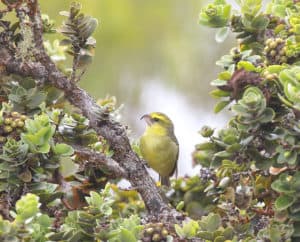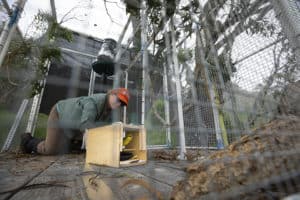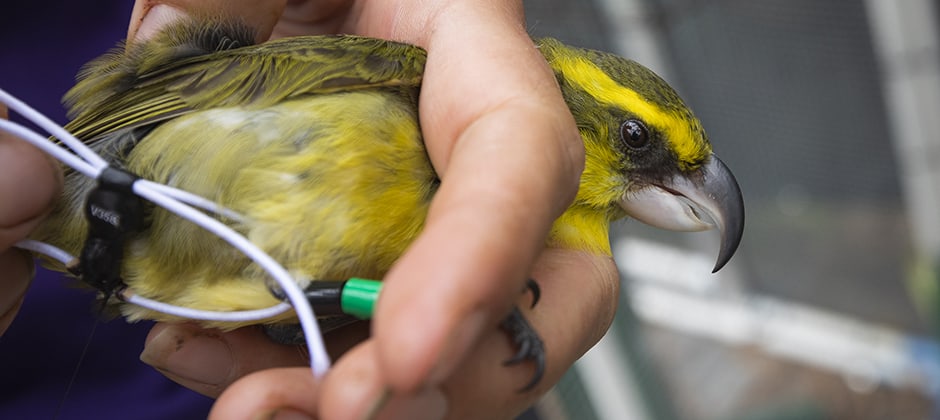Share this article
Conservationists race to save Hawaiian kiwikiu honeycreeper
A Hawaiian bird endemic to Maui is running out of chances after avian malaria scuttled a recent translocation attempt in a remote area of the island.
“The best chance for these guys was to start building new habitat and translocate them to a new area,” said Hanna Mounce, the coordinator of the Maui Forest Bird Recovery Project. But a rash of warmer than usual weather may have contributed to an influx of avian malaria-carrying mosquitoes in an area previously believed to be free of the disease due to its altitude.
The kiwikiu (Pseudonestor xanthophrys), also known as the Maui parrotbill, is listed as endangered by the U.S. Fish and Wildlife Service. As recently as several months ago, researchers believed about 300 individuals were left in the world, captive or wild.
“The bottom line is they are absolutely going extinct where they are. We know that they are rapidly declining. We know that we can’t manage them there,” Mounce said.
In October, the MFBRP worked with partners in the American Bird Conservancy, San Diego Zoo Global, U.S. Fish and Wildlife Service, and the Hawaii Department of Land and Natural Resources on a translocation project to bring captive birds, plus a few wild birds from a suffering population in Hanawi Natural Area Reserve, to a new area they thought should free from some of the problems that have contributed to the species’ decline.

Kiwikiu numbers have declined rapidly due to a mixture of avian malaria and problems caused by invasive plants and wildlife. ©Bret Mossman c/o Maui Forest Bird Recovery Project
These Hawaiian honeycreepers traditionally lived in dryer forests on slopes in Maui at altitudes of 500 feet and higher. The birds feed on insects they dig out of native Hawaiian trees, but they suffer from habitat loss and introduced disease, avian malaria, which was introduced to the state in the 1800s. Invasive plants also contribute to habitat loss and invasive predators like rats (Rattus rattus) and cats (Felis catus) kill the birds.
The translocation project moved seven wild birds and a half-dozen more from captive populations from San Diego Zoo Global into the fenced Nakula Natural Area Reserve on the leeward side of the island where conservationists had been working to restore native wildlife conditions. The area was thought to be ideal, especially because of its altitude. Conservationists believed that anything above 5,000 feet should be relatively free from the mosquitoes that carry avian malaria, validated through pre-release mosquito and disease surveys.
The problem was that 2019 had seen particularly warm weather that seems to have allowed the mosquitoes to increase their range. “Basically, it looks like the warm weather in the past year has brought the disease level much higher than it was before,” Mounce said. “There’s nothing that we can do with the current tools available to mitigate the additional threats acting on them.”
As a result, nearly all of the kiwikiu birds that were translocated to this area died. Only one male known is known be alive in the area and another’s current state is unknown since its transmitter stopped working.
The trouble with reintroduction projects aren’t unique to these birds. A recent study found that reintroduction or translocation projects often fail due to a number of different issues.
“Translocations are risky and often things happen that are unforeseen,” Mounce said.

Hanna Mounce in a pre-release aviary with a kiwikiu intended for translocation. ©Zach Pezzillo c/o Maui Forest Bird Recovery Project
She said the bird population in the Hanawi reserve they were taken from were rapidly declining and at least this gave them a chance, but the results are still very unfortunate.
“Those birds were going to die anyway, but it’s very shocking when it basically happens in your hands,” she said.
More recent surveys suggest the birds’ numbers may be even lower than previously thought, with only 50 to 100 individuals, including a few in captivity.
But Mounce believes there is still hope now that wildlife managers have learned from recent issues. Habitat above 6,000 feet is still believed to be free from malaria-carrying mosquitoes, which may provide the birds some solace.
After this setback, researchers are speeding efforts to control the mosquitoes using a cutting edge technique involving releasing mosquitoes carrying incompatible strains of a natural bacteria called Wolbachia. This would reduce the mosquitoes’ ability to breed and transmit disease.
Mounce said the good news is the birds’ distress has drawn more attention, which could mean more conservation money and action.
“The silver lining at the moment is that many people are paying attention,” Mounce said, adding that conservationists are now bringing more of the vulnerable birds into protected areas while the mosquito issue is being worked out.
Header Image:
A researcher attaches a transmitter to a kiwikiu, or Maui parrotbill, which are endemic to Maui, Hawaii.
©Zach Pezzillo c/o Maui Forest Bird Recovery Project








